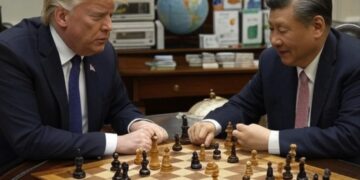U.S. President Donald Trump and Israeli Prime Minister Benjamin Netanyahu unveiled a 20-point Gaza peace plan that could either end nearly two years of bloodshed or ignite a broader regional firestorm. Billed as a path to “eternal peace,” the proposal—announced on September 29, 2025—offers phased Israeli withdrawal, hostage releases, and massive reconstruction but comes with a stark ultimatum to Hamas: accept or face annihilation with full U.S. backing. For investors, diplomats, and global markets, this high-stakes deal is a tightrope walk between economic windfalls and catastrophic escalation.
The plan, a spiritual successor to Trump’s 2020 “Peace to Prosperity” vision, emerged from intense talks amid the Gaza war’s grinding toll—over 40,000 Palestinian deaths and 1,200 Israeli losses since Hamas’s October 7, 2023, attack. Trump, flanked by Netanyahu, exuded dealmaker swagger, claiming, “We’re beyond very close,” while touting the Abraham Accords’ legacy. Netanyahu, nodding vigorously, called it a framework to “bring back all our hostages, dismantle Hamas’ military capabilities, end its political rule, and ensure Gaza never again poses a threat to Israel.” Notably absent? Palestinian input—Hamas wasn’t consulted, and the Palestinian Authority offered only tepid acknowledgment.
The proposal’s core hinges on immediate action: within 72 hours of agreement, Hamas must release all ~100 remaining hostages taken in 2023, while Israel frees hundreds of Palestinian prisoners. Humanitarian aid would surge, matching January 2025 levels with infrastructure repairs and rubble clearance. Israel would then withdraw in stages to an “agreed line,” handing territory to an interim “Israeli Security Force” before a full exit—though retaining a border perimeter and security veto. Hamas fighters face a grim choice: decommission weapons for amnesty or accept exile, with no role in Gaza’s future governance.A technocratic Palestinian committee, excluding Hamas and PA politicos, would run daily operations under a “Board of Peace” chaired by Trump, with former UK PM Tony Blair as a key figure. Reconstruction, bankrolled by $50-100 billion from U.S. and Arab coffers, promises a rebuilt Gaza—but no firm path to statehood.The deal’s allure for stakeholders is clear. Acceptance could stabilize Red Sea shipping, easing 5-10% oil price premiums from Houthi disruptions, and unlock $20 billion in tenders for rubble removal and hospital rebuilds. Gulf states, eyeing Abraham Accords expansion with Saudi Arabia, see economic upside in a $200 billion regional boon by 2030. Qatar, a mediator, gains clout—Netanyahu even apologized for a prior killing of a Qatari officer to smooth talks. But the plan’s asymmetry—no settlement freezes, indefinite Israeli oversight, and Trump’s quip about Gaza’s “wasted ocean” waterfront—has sparked fury. Hamas, via Qatari channels, decried it as an “American-Israeli agreement” for “continued aggression,” while allied Islamic Jihad warned of a “recipe for regional explosion.” spcial media users split sharply, with pro-Israel voices cheering and activists slamming it as a “surrender disguised as salvation.”Global reactions are mixed. Spain’s Pedro Sánchez hailed an end to “so much suffering,” but the EU’s Antonio Costa urged a viable two-state path. Canada’s Mark Carney pledged aid but stressed Palestinian sovereignty. Trump’s team, led by Press Secretary Karoline Leavitt, insists “Hamas wants this done,” and Special Envoy Steve Witkoff claims Gulf and European buy-in. Yet, Hamas’s silence as of September 30 morning, coupled with last week’s UN recognition of Palestinian statehood, signals trouble. The October 7 anniversary looms as a potential flashpoint. For stakeholders, the calculus is brutal. Acceptance could greenlight reconstruction and normalization, but rejection risks Trump and Netanyahu’s “any means necessary” vow, potentially drawing in Hezbollah or Iran. Markets should hedge into renewables as Gulf states pivot, while tracking Qatar’s mediation for breakout signals. This “eternal peace” pitch might reshape the Middle East—or blow it apart. Either way, the clock is ticking.






































